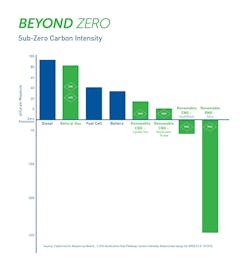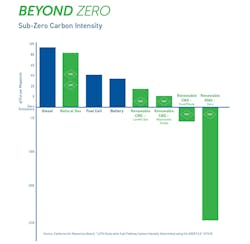Renewable natural gas (RNG) has been receiving a lot of buzz lately. You may have seen this recent headline: UPS makes largest purchase of renewable natural gas ever in the US.
UPS contracted with Clean Energy to purchase 170 million-gallon equivalents of RNG. Fleet Owner ran an article about how RNG supply and demand in the US transportation sector will grow rapidly over the next five years.
What exactly is RNG? Why is RNG becoming the next big thing in transportation fuels? Does RNG really have emissions below zero? Let’s explore these and other important questions.
What is RNG?
RNG is sustainable recycled organic waste. Organic waste includes food waste from our tables, green waste from our landscaping, unpleasant waste from sewage treatment plants, and agricultural waste such as dairy cow manure. These wastes produce methane gas as they naturally decay. The idea for RNG is elegant and simple. Rather than let the methane from organic decay escape into the atmosphere and contribute to climate change, the methane gas is captured and used as fuel. Methane in RNG is the same chemical compound that is the main component of natural gas. This means that RNG is a completely compatible drop-in replacement for traditional natural gas. More information about RNG can be found on the RNG Coalition Website or the Clean Energy Redeem RNG page.
What are RNG supply sources?
Originally, RNG was predominately produced at landfills and sewage treatment plants. The diversity of supply sources has dramatically expanded as the RNG production industry has grown. Local company CR&R is a great example of the innovation in supply that is occurring. CR&R constructed an RNG production plant in southern California. CR&R can divert organic waste from going into landfills. Instead, the organic waste is processed into RNG through a process called anaerobic digestion.
Dairy farms are another growing success story. Dairy cattle produce a lot of milk, and a lot of cow poop. Cow manure is processed to capture the methane emissions for RNG. Chevron recently announced an initiative with dairy farmers and CalBio to increase RNG from dairies There are currently 81 dairy digesters in operation or construction in California. This article is another good resource on the topic.
The RNG Coalition tracks RNG plants in the US and Canada. There are currently 99 operational RNG plants, 27 more that are under construction, and 39 in substantial development.
Why is RNG the next big thing?
There is much talk today about aspirational goals of achieving zero emissions, zero waste, zero footprint and so forth. RNG is a transformative technology that asks: why stop at zero? RNG makes it possible for transportation to have less than zero climate-harming emissions of greenhouse gases. If zero is good, then below zero is better. Ultimately to get serious about fighting climate pollutants, then technologies that are below zero are essential.
Importantly, the most vital emissions reductions occur today, not in the future. RNG is transformative because this technology is being used today and is a plug-and-play solution for heavy duty trucks and other vehicles. Society does not need to wait for a future technology to enter the market when the best solution is already available today.
Who is using RNG?
The articles cited earlier name UPS and CR&R as big RNG users. However, there are many more. Every Clean Energy customer in California is already using RNG. Nationally, 32% of the natural gas consumed by US vehicles in 2018 was RNG.
Are RNG emissions really below zero?
Facts matter when it comes to fighting climate change. While all RNG sources have lower climate pollutant emissions than diesel, not all sources are below zero. The emissions profile of every RNG source is carefully determined under federal and state regulations. Typically, RNG from landfills and sewage plants have great emissions reductions but are not below zero. RNG from dairy farms and waste digesters are often below zero. This chart illustrates the comparative emissions of competing fuels and technologies.

